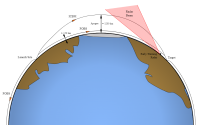About this, I've been discussing the pros and cons with someone else who's more into ballistic missiles than me and he's given me the following reason why FOBS is mated to a HGV:
One thing that people don't often realise is that FOBS use an trajectory that's very different from a regular ICBM. A regular ICBM achieves a very high apogee of over 1000km while a FOBS would use a very low "parking orbit" as it would be called in aerospace trade of no more than 200km. Because it flies so low and "hugs the ground" as it were it's much more difficult for ABM radars to detect in time. FOBS also reach the target faster because it actually reaches nearly 8km/s while ICBMs are often under 7km/s
So FOBS inherently has an advantage penetrating ABM defended area because it flies lower and faster, however when it nears the target and actually deorbits to attack it's no different from regular ICBM and subject to potential terminal phase interception.
A HGV has inherent advantage in dodging terminal phase interception thanks to its atmospheric manoeuvrability. Note also, once a HGV begins its glide it cannot be engaged by mid course interception any more. Mid course interceptor are exoatmospheric and cannot stand up to the raging heat of flying through the upper atmosphere at near orbital velocity without their fairing. If you want to design an interceptor to hit HGV in its glide phase it will have to have similar thermal protection as the HGV.
So basically a HGV compared to a regular warhead has a very long terminal phase and is tricky to hit during this phase too. What this means is if a HGV is mated to a FOBS by the time you detect the FOBS coming over the horizon (assuming you do! You may never see it coming thanks to it's ability to attack from any direction) it would have already either released or is about to release the HGV, thus giving you very small window to attempt a mid course interception before HGV begins gliding and can only be engaged with the relatively limited ranged terminal phase interceptors like THAAD.
Note that if HGV is used as warhead for a conventional ICBM than this ICBM is subject to mid course interception just the same as any other ICBM. The HGV can glide a long way but not 10,000s of kilometre.
One possible solution we came up with to counter this type of weapon is the old Cold War 1.0 hardcore, balls to the wall setup: nuclear tipped terminal phase interceptors like the Sprint missile. But even so the amount of area it could protect would be limited.
So in summery:
FOBS - makes mid course interception harder
HGV - makes terminal phase interception much harder, also makes mid course phase end earlier
By adding the two together you let the advantage of each cover the weakness of the other.


